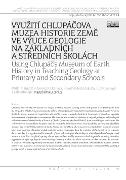Využití Chlupáčova muzea historie Země ve výuce geologie na základních a středních školách
( Using Chlupáč's Museum of Earth History in Teaching Geology at Primary and Secondary Schools )

Datum vydání
2020Publikováno v
Biologie-Chemie-ZeměpisRočník / Číslo vydání
29 (1)ISBN / ISSN
ISSN: 1210-3349Metadata
Zobrazit celý záznamKolekce
Tato publikace má vydavatelskou verzi s DOI 10.14712/25337556.2020.1.4
Abstrakt
Chlupáčovo muzeum historie Země (dále "Muzeum") je unikátní akademická expozice, zaměřená na vývoj planety Země z pohledu živé i neživé přírody, která je primárně určená k výuce vysokoškolských studentů. Její názornost a v jistém smyslu kompaktnost ji však umožňuje využít i ke vzdělávání studentů a žáků nižších studijních stupňů, zvláště pokud je doplněna vysvětlujícím komentářem. Vznikla na základě původních geologicko-paleontologických sbírek soustředěných po 2. světové válce z několika pražských vysokých škol na Přírodovědecké fakultě Univerzity Karlovy (dále PřF UK). Sbírky byly nepřístupné veřejnosti až do přelomu tisíciletí, kdy bylo rozhodnuto o rekonstrukci a přestavbě na muzeum, které by mohlo být aspoň v omezené otevírací době otevřeno i pro veřejnost. Vlastní expozice "Muzea" je ucelený soubor fosilního materiálu, názorných modelů, informačních tabulí, které popisují vývoj Země od jejího vzniku až po současnost. Je doplněna i ukázkami vybraných paleoekologických vztahů v některých obdobích, tafonomickými unikáty a obrazovými rekonstrukcemi. Od svého oficiálního otevření začalo být "Muzeum" využíváno četnými školami (zvláště středními) k doplnění nebo nahrazení výuky geologických témat. V současnosti jsou školní exkurze stěžejními návštěvníky "Muzea". Kromě vlastních komentovaných přednášek mohou studenti a žáci zpracovávat i pracovní listy, které umožňují výklad si lépe zapamatovat. Do budoucna by se jistě dalo "Muzeum" intenzivněji využít k doplnění výuky geologie, která je na středních školách opomíjena.
Chlupáč's Museum of Earth History is a unique academic museum focusing on the development of the planet Earth from the perspective of both living and inanimate nature, which is primarily intended for teaching university students. However, its clarity, and, in a sense, its compactness, allows it to be used to educate students at lower levels of education, especially if accompanied by explanatory commentary. The museum was created on the basis of original geological-paleontological collections amassed at the Faculty of Science of Charles University, after World War II, from several Prague universities. The collections were inaccessible to the public until the turn of the millennium, when it was decided to renovate and rebuild the museum and open it to the public for at least a limited amount of time. The museum's (own) exhibition is a comprehensive set of fossil materials, illustrative models, and information posters describing the evolution of the Earth from its origins to the present day. It is supplemented by examples of some paleoecological relationships in selected periods and unique visual reconstructions. Since its official opening, the museum has been used by numerous schools (especially secondary schools) to supplement or replace geological science teaching. Currently, students on school excursions are key visitors to the museum. In addition to lectures organized by the museum, students can also complete worksheets, which make the material easier to interpret and memorize. In the future, the museum could certainly be used more intensively to complement the teaching of geology, which is a very neglected area at secondary schools.
Klíčová slova
muzeum, geologie, paleontologie, výuka, exkurze
museum, geology, paleontology, education, excursion
Trvalý odkaz
https://hdl.handle.net/20.500.14178/1932Licence
Licence pro užití plného textu výsledku: Creative Commons Uveďte původ 4.0 International




